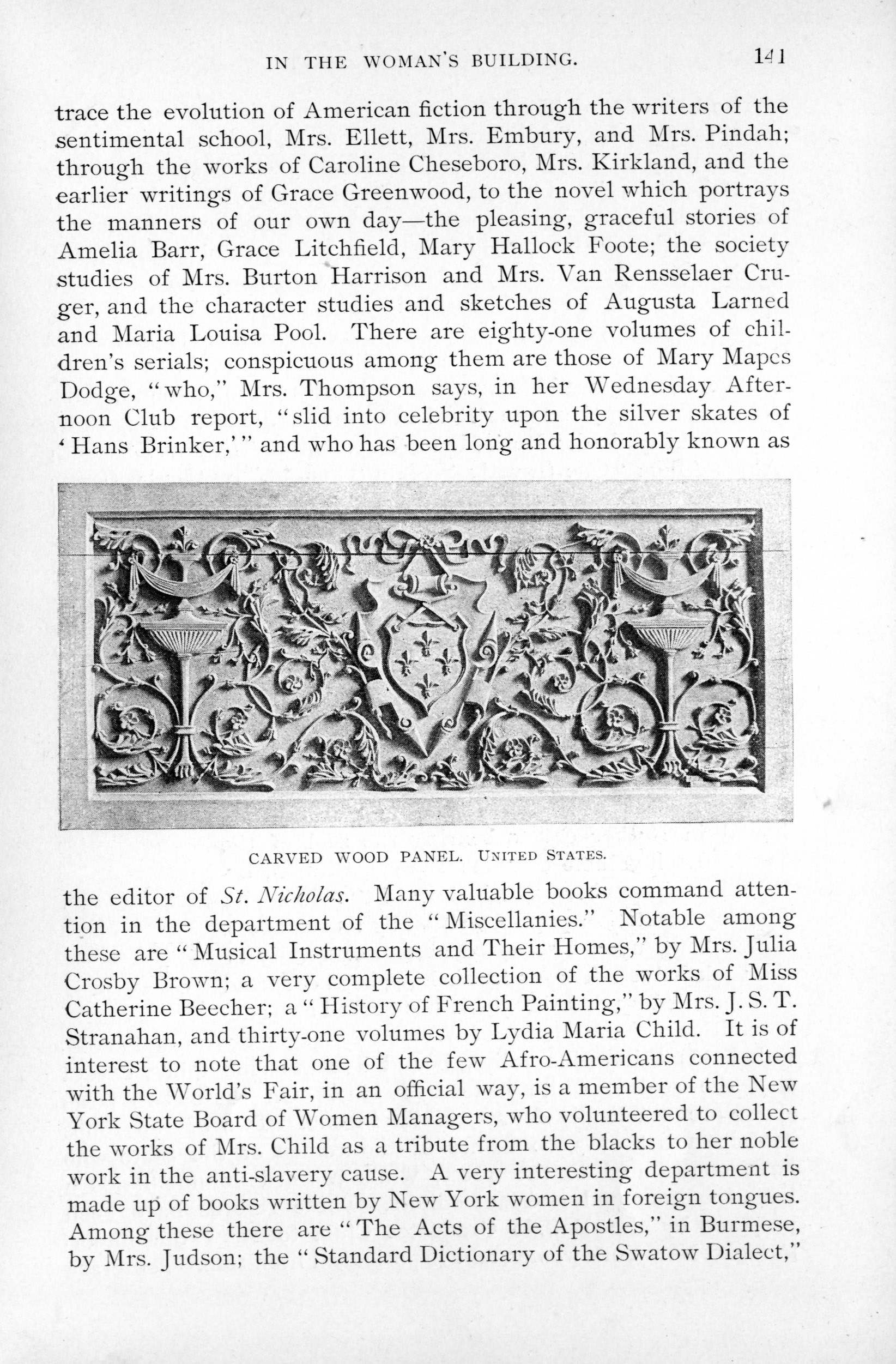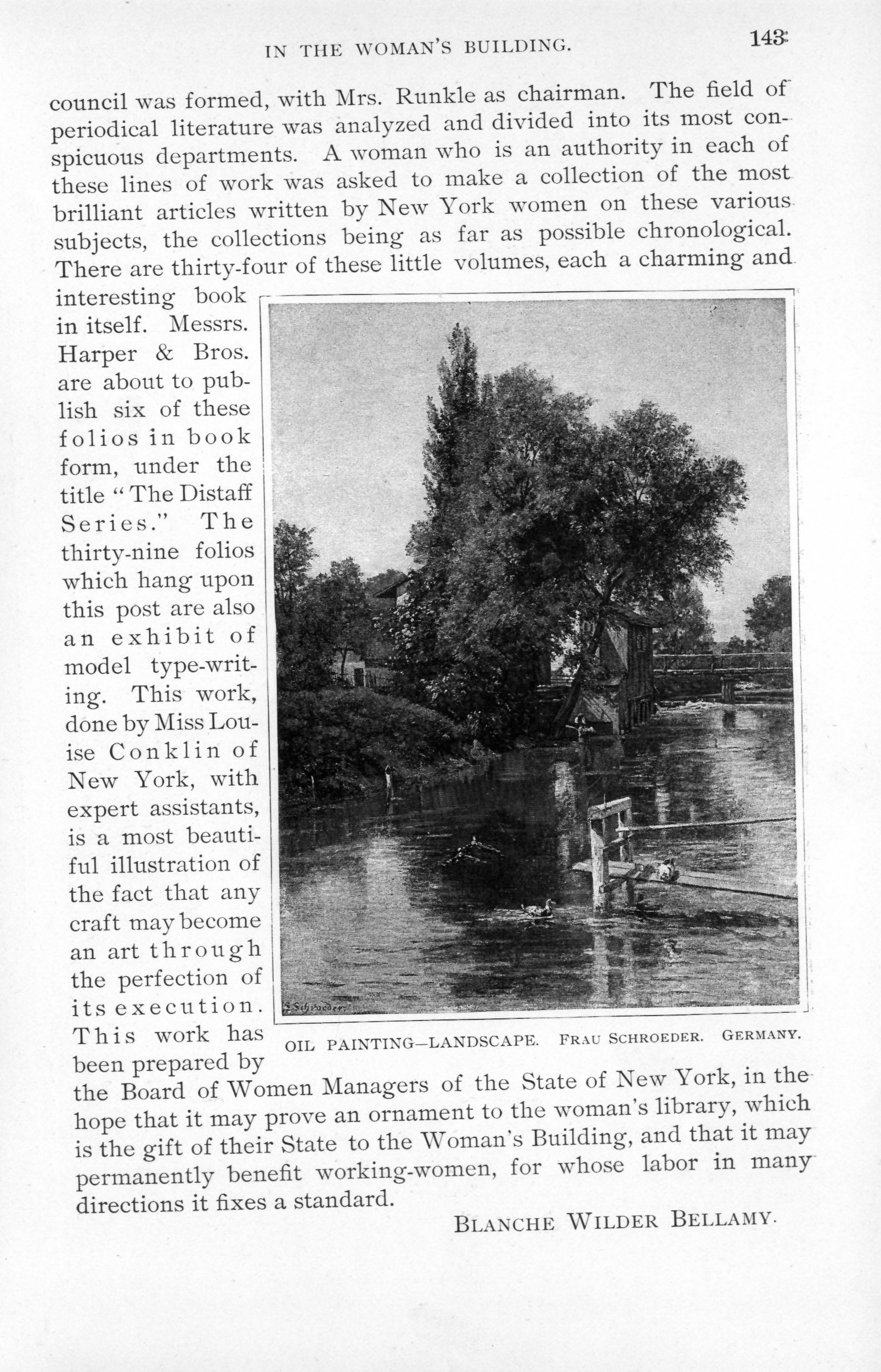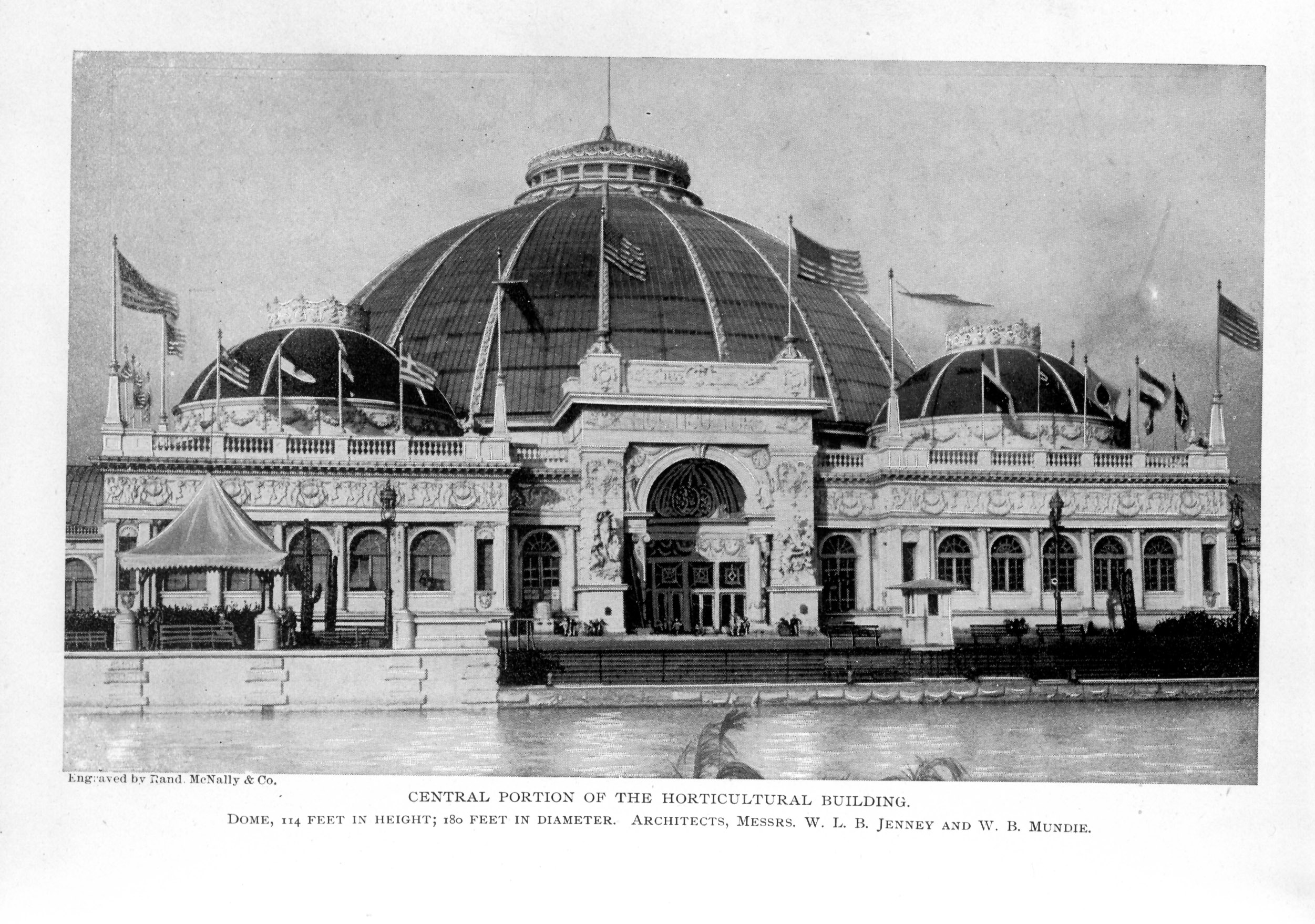
SEAL OF NEW YORK STATE BOARD.
LYDIA EMMET. (Copyrighted.)
NEW YORK LITERARY EXHIBIT.
THE chairman of the Committee on Literature of the Board of Women Managers of the State of New York has organized and instituted an exhibit differing somewhat in character from any other in the library. It contains three departments: First, women's work in the writing and translating of books; second, their work in literary clubs and classes; and third, their work in journalism and in periodical literature.
The collection of books, which numbers 2,400 volumes, was made by the Wednesday Afternoon Club of New York, which contributed $1,000 to this end. We have attempted to make an historic, chronologic collection of all the books ever written by women either residents or natives of the State of New York. It is believed that this will prove of benefit to future students of literature and lovers of Americana. It is a collection limited both by sex and locality, but valuable because of its completeness within these limits. The Committee of the Wednesday Afternoon Club, under the efficient chairmanship of Mrs. Frederick Ferris Thompson, aided by Mrs. Charles Royce, Miss Willard, Mrs. Richard Ewart, Mrs. Alfred Corning Clark, Mrs. Junius

CARVED OAK MIRROR FRAME.
MISS REEKS. ENGLAND.
Henri Browne, and others, with the special support and aid of Mrs. Runkle, the brilliant literary critic of New York and the president of the club, has done a very thorough and exhaustive work. Great assistance has been rendered by the committees in each county of the State, by several of the well-known publishers, and by most of the authors represented. The collection contains children's books, works of fiction, science, cookery, and household economics, education, language, translation, original verse, compiled verse, travels, biography, history, art, and religion. The oldest book is a novel, "The Female Quixote," by Charlotte Ramsay Lennox, who is said to have been the first native-born author of the province of New York. This young girl at the age of sixteen went from the wild-beast-ridden, Indian-haunted wilds of the west, in the province of New York, to the gay metropolis of London. Here she was much courted and fêted. Among her admirers were Smollett, Fielding, Richardson, and Doctor Johnson—the latter wrote epilogues and prologues for her plays, championed her novels and poems, and made her the fashion of the hour. From this eighteenth century beginning we may

CARVED WOOD PANEL.
UNITED STATES.
trace the evolution of American fiction through the writers of the sentimental school, Mrs. Ellett, Mrs. Embury, and Mrs. Pindah; through the works of Caroline Cheseboro, Mrs. Kirkland, and the earlier writings of Grace Greenwood, to the novel which portrays the manners of our own day—the pleasing, graceful stories of Amelia Barr, Grace Litchfield, Mary Hallock Foote; the society studies of Mrs. Burton Harrison and Mrs. Van Rensselaer Cruger, and the character studies and sketches of Augusta Larned and Maria Louisa Pool. There are eighty-one volumes of children's serials; conspicuous among them are those of Mary Mapes Dodge, "who," Mrs. Thompson says, in her Wednesday Afternoon Club report, "slid into celebrity upon the silver skates of 'Hans Brinker,'" and who has been long and honorably known as the editor of St. Nicholas. Many valuable books command attention in the department of the "Miscellanies." Notable among these are "Musical Instruments and Their Homes," by Mrs. Julia Crosby Brown; a very complete collection of the works of Miss Catherine Beecher; a "History of French Painting," by Mrs. J. S. T. Stranahan, and thirty-one volumes by Lydia Maria Child. It is of interest to note that one of the few Afro-Americans connected with the World's Fair, in an official way, is a member of the New York State Board of Women Managers, who volunteered to collect the works of Mrs. Child as a tribute from the blacks to her noble work in the anti-slavery cause. A very interesting department is made up of books written by New York women in foreign tongues. Among these are "The Acts of the Apostles," in Burmese, by Mrs. Judson; the "Standard Dictionary of the Swatow Dialect,"

BOOK COVER.
BOSTON COLLECTION.
UNITED STATES.
"The Life of Christ," and a volume of translations of some of the most familiar English hymns, in this dialect, by Miss Adele Field; "The Peep of Day," in Arabic, by Ellen Jackson Foote; "Early Church History" and "Legends of Helena, and Monica the Mother of St. Augustine," in Hindustani, by Mrs. Humphrey; a number of books written in German by Talvi (Mrs. Edward Robinson)—many of these have great literary and historical value; and one translation from English into French, entitled "Dans un Phare." In scientific literature we have an especially valuable collection of medical works by the women doctors of the State, while in the 219 volumes of original verse, many well-known songs and lyrics are to be found. Conspicuous among these are "Rocked in the Cradle of the Deep," by Mrs. Anna Willard; "Rock Me to Sleep, Mother," by Mrs. Elizabeth Akers Allen; "One Sweetly Solemn Thought," by Phœbe Carey; "I Love to Steal Awhile Away," by Mrs. Francis Brown; and last and best known, the famous lyric, "The Battle Hymn of the Republic," by Mrs. Julia Ward Howe. In history we have the "Standard Colonial History of New York," by Mrs. Martha J. Lamb; the "History of Woman Suffrage," by Susan B. Anthony, and the "Sabbath in Puritan New England," by Mrs. Alice Morse Earle.
These books, with many others of great value and interest, form only the first part of the New York exhibit. The second part consists of a showing of the work of seventy-five literary clubs and classes in the State. These records are type-written, and beautifully bound in leather covers bearing the seal of the State. Each volume contains the constitution, bylaws, list of members, and history of the club, with four representative papers, written by its members. These hang upon a standard at one extremity of the bookshelves. These records have been collected and installed by Sorosis, which has served as a sub-committee for the Board of Women Managers. Another standard holds thirty-nine folios, bound like the club folios, except that the seal is white instead of blue. On these two posts there are practically four exhibits in one. Two of the folios contain a list of 3,000 names of the women of the State who have contributed to the press, while a third volume holds a list of editors and assistant editors. These records have been prepared by the Buffalo Graduates Club, to show the important part New York women take in periodical literature. A literary

OIL PAINTING—LANDSCAPE.
FRAU SCHROEDER.
GERMANY.
council was formed, with Mrs. Runkle as chairman. The field of periodical literature was analyzed and divided into its most conspicuous departments. A woman who is an authority in each of these lines of work was asked to make a collection of the most brilliant articles written by New York women on these various subjects, the collections being as far as possible chronological. There are thirty-four of these little volumes, each a charming and interesting book in itself. Messrs. Harper & Bros. are about to publish six of these folios in book form, under the title "The Distaff Series." The thirty-nine folios which hang upon this post are also an exhibit of model type-writing. This work, done by Miss Louise Conklin of New York, with expert assistants, is a most beautiful illustration of the fact that any craft may become an art through the perfection of its execution. This work has been prepared by the Board of Women Managers of the State of New York, in the hope that it may prove an ornament to the woman's library, which is the gift of their State to the Woman's Building, and that it may permanently benefit working-women, for whose labor in many directions it fixes a standard.
BLANCHE WILDER BELLAMY.

THE NORTHERN PAVILION OF HORTICULTURAL BUILDING AND EXHIBIT OF HOT-HOUSES AND SUMMER-HOUSES.

PANEL—"INFLUENCE OF WOMAN IN THE ARTS. SHE WEEPS WITH THE POET,
CONSOLES HIM, AND GLORIFIES HIM." FRANCE.
PANEL—"THE ARTS OF WOMAN. TO LOVE, TO PLEASE, AND DEVOTE HERSELF."
FRANCE.

CENTRAL PORTION OF THE HORTICULTURAL BUILDING.
DOME, 114 FEET IN HEIGHT; 180 FEET IN DIAMETER. ARCHITECTS, MESSRS. W. L. B. JENNEY AND W. B. MUNDIE.